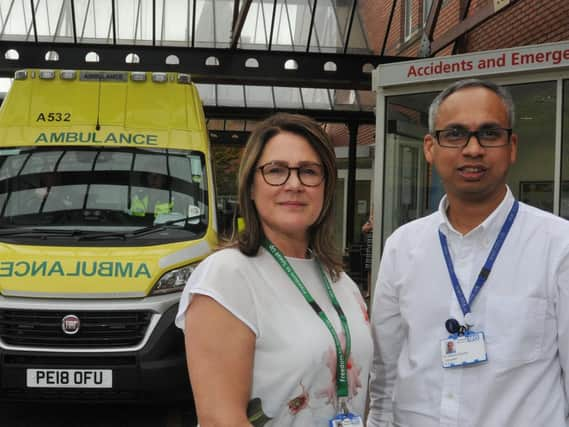Wigan A&E is already gearing up for busy winter months


But there was unprecedented demand for emergency care last winter.
Other news: Senior figures pay tribute to outgoing Wigan Council CEO Donna HallWigan Infirmary was inundated with patients, with waiting times soaring and people urged to seek treatment elsewhere if possible.
Advertisement
Hide AdAdvertisement
Hide AdKeen to prevent problems this winter, preparations are already well under way.
While she said there were “no guarantees”, Mary Fleming, director of operations and performance at Wrightington, Wigan and Leigh NHS Foundation Trust, hopes things will run more smoothly this time.
She said: “I have never seen such a really effective winter plan from the Wigan locality that ticks all the boxes. I have never seen anything that’s so focused on the areas we need to focus on.
“That’s not to say winter will be plain sailing, because it isn’t, but I feel so much more assured now with the schemes to keep people away from hospital, to get them where they need to be but also move them quickly through the hospital for those who need to be here and most importantly allow the time to get to the poorliest patients very quickly.”
Advertisement
Hide AdAdvertisement
Hide AdOne of the main focuses is avoiding admissions, so there are fewer patients to be seen in the first place.
Changes have already been made in the A&E unit to reduce waiting times and it is hoped they will continue to make a difference this winter.
Many patients who attend A&E do not need emergency treatment, so they are now sent to Christopher Home’s primary care centre or the minor injuries unit.
GPs have been working there from 10am to 10pm, with this being extended to 24 hours a day, and appointments can be booked rather than people having to wait for diagnostic tests, for example.
Advertisement
Hide AdAdvertisement
Hide AdMs Fleming said it had been “hugely successful” and around 25 per cent of patients going to A&E had been streamed away.
This means staff in A&E are able to treat the patients who are most seriously ill or injured more quickly.
A key way of tackling waiting times is ensuring there are enough free beds and the trust is proud of the work being done to reduce bed blocking through its integrated discharge hub.
There are also now 10 step-up beds, provided by Bridgewater Community Healthcare NHS Foundation Trust, and a community response team referring patients to GPs and community services, rather than taking them to hospital.
Advertisement
Hide AdAdvertisement
Hide AdIt saw 488 patients referred in a month and it has meant 547 fewer ambulances going to Wigan’s A&E unit.
Ms Fleming said: “They are finding alternative ways of managing patients - frail, elderly patients who often have complex social needs but not medical needs - and they are managing them through the community response team and the 10 step-up beds which I think have been a massive contributor to our performance.
“If those patients had been at A&E, I think we would have been really struggling.”
A clinical liaison officer will help to manage the flow of patients in A&E, working alongside the ambulance liaison officer.
Advertisement
Hide AdAdvertisement
Hide AdOther things being done to manage patient flow include reverse queueing, where a patient waiting for test results, for example, will be sent back to the waiting room so another patient can be seen in the room by the doctor.
Ms Fleming said a lot of work was being done across the health system in Wigan, not just within the hospitals, to help patients this winter.
They feed into the “home first” strategy, which aims to keep people in their homes for as long as possible rather than admitting them.
Work is being done with other areas too, as ambulances are sometimes diverted to Wigan A&E from elsewhere, such as Lancashire.
Advertisement
Hide AdAdvertisement
Hide AdDr Shariq Ahmed, clinical director in A&E, said steps being taken to prepare for winter included changes to rotas for all levels of medical staff.
He said: “Staffing has always been a problem. It’s one of the biggest problems in the NHS and we have tried getting our staff right.”
Schemes have also been implemented to encourage staff to help cover shifts and there was a “really fantastic health and well-being programme” to support them.
With everything being done, it is looking positive for winter.
Advertisement
Hide AdAdvertisement
Hide AdDr Ahmed said: “We have had a fair few dry runs already. We often worry about winter in terms of the patients seen and the bed occupancy. The months of July and August weren’t the lightest. We consistently saw 30, 40 more patients than we normally would be seeing.
“If winter is a bad period, summer is worse in terms of staffing and patient flow, but we have managed this fairly well.”
Wiganers are also being urged to do their bit to ease the pressure on A&E this winter.
Dr Ahmed said: “Members of the public can choose well. There are so many other services in the community they can access, from GPs to pharmacists.
Advertisement
Hide AdAdvertisement
Hide Ad“No-one is stopping them coming to A&E - it’s a 24/7 service so they can come and no-one will stop them - but choose well.”
He also suggested people consider when they attend A&E if possible, with high attendance on Mondays and surges between 4pm and 8pm.
Ms Fleming urged people only to call 999 for an ambulance when essential too, so paramedics can get to people who really need their help.